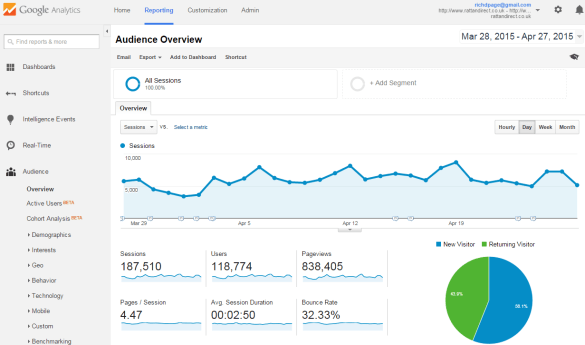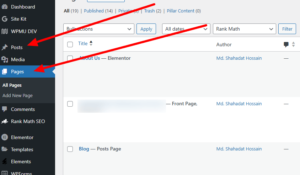Yes, you can use Google Analytics on any website. It supports various platforms, including HTML, WordPress, and e-commerce sites.
Google Analytics offers detailed insights into your website’s performance. It helps track user behavior, traffic sources, and conversion rates. Setting it up is straightforward, requiring only a tracking code added to your site’s pages. This powerful tool is essential for optimizing your online presence.
It aids in understanding visitor interactions, which can drive better marketing strategies. Whether you run a blog, online store, or corporate site, Google Analytics can provide valuable data. Start leveraging its features to enhance user experience and achieve business goals. Its versatility and ease of use make it a must-have for website owners.

Credit: www.rich-page.com
Getting Started
Google Analytics is a powerful tool. It helps you understand your website’s performance. Getting started with it is easy and quick. This guide will help you set up Google Analytics on your website.
Creating A Google Analytics Account
First, you need a Google account. If you don’t have one, create it. Follow these steps to create a Google Analytics account:
- Go to the Google Analytics website.
- Click on the Start for free button.
- Sign in with your Google account.
- Click on the Set up for free button.
- Fill in your Account Name and click Next.
Setting Up Your First Property
After creating your account, you need to set up your first property. A property represents your website or app. Follow these steps:
- Click on the Property Setup screen.
- Enter your Property Name.
- Select your Reporting Time Zone.
- Choose your Currency.
- Click Next to proceed.
Google Analytics will then generate a Tracking ID. You need to add this ID to your website. This allows Google Analytics to track your website’s data.
Here is a simple example of how to add the tracking code:
Replace YOUR_TRACKING_ID with the actual Tracking ID provided by Google Analytics.
And that’s it! You have now set up Google Analytics on your website. You can start tracking and analyzing your website’s performance.

Credit: www.analyticsmania.com
Compatibility
Google Analytics is a versatile tool. It works with various websites and platforms. Understanding its compatibility helps you maximize its potential. Let’s delve into the supported platforms and third-party integrations.
Supported Platforms
Google Analytics supports a wide range of platforms. It works seamlessly with most content management systems (CMS). Here’s a list of some supported CMS:
- WordPress
- Joomla
- Drupal
- Wix
- Squarespace
It also works with custom-built websites. You can add the tracking code to any HTML page. This makes it highly flexible.
Third-party Integrations
Google Analytics offers various third-party integrations. These integrations enhance its functionality. Here are some common integrations:
| Service | Function |
|---|---|
| Google Ads | Track ad performance |
| Google Search Console | Monitor site search traffic |
| Shopify | Track e-commerce data |
| Mailchimp | Monitor email campaign performance |
These integrations provide deeper insights. They help you understand user behavior better. This improves your overall strategy.
Installation
Installing Google Analytics on your website is simple. This guide will help you understand the steps. Follow these steps to start tracking your website’s data.
Adding The Tracking Code
To add the tracking code, follow these steps:
- Sign in to your Google Analytics account.
- Select the property you want to track.
- Navigate to the Admin section.
- Under the Property column, click Tracking Info.
- Click Tracking Code.
- Copy the provided code.
- Paste this code into the section of your website.
The tracking code will start collecting data. Ensure the code is on every page you want to track.
Using Google Tag Manager
Google Tag Manager (GTM) simplifies the process. Follow these steps:
- Create a GTM account if you don’t have one.
- Set up a new container for your website.
- Copy the container snippet code.
- Paste the code into the head section of your website.
- In GTM, click Tags and then New.
- Select Google Analytics: Universal Analytics as the tag type.
- Enter your Google Analytics tracking ID.
- Set the trigger to All Pages.
- Save and publish your tag.
Using GTM, you can manage tags without modifying your website’s code. This method is flexible and user-friendly.
Configuration
Google Analytics is a powerful tool for tracking your website’s performance. Proper configuration is essential for gaining meaningful insights. This section will guide you through setting up goals and customizing reports. These steps will ensure your data is accurate and useful.
Setting Up Goals
Goals help you measure specific actions on your website. These actions could be form submissions, product purchases, or newsletter sign-ups. To set up goals, follow these steps:
- Navigate to the Admin panel in Google Analytics.
- Under the View column, click on Goals.
- Click on the New Goal button.
- Select a template or create a custom goal.
- Define the goal details, including type and value.
- Click Save to apply the goal.
Setting up goals helps you track important actions. You can understand what drives success on your site.
Customizing Reports
Custom reports allow you to see the data that matters most to you. Here is how to customize reports:
- Go to the Customization tab in Google Analytics.
- Select Custom Reports from the dropdown menu.
- Click the New Custom Report button.
- Enter a name for your report.
- Choose the metrics and dimensions you want to include.
- Apply filters to refine your data further.
- Save your custom report.
Customizing reports helps you focus on the most relevant data. This feature is essential for in-depth analysis.
In summary, configuring Google Analytics properly is vital. Setting up goals and customizing reports will make your analytics more effective.
Advanced Features
Google Analytics offers many advanced features to help you understand your website’s performance. By using these features, you can gain deeper insights into user behavior and make better decisions for your site.
Event Tracking
Event tracking lets you track specific user interactions on your website. This includes clicks, form submissions, and video plays. By setting up event tracking, you can see how users engage with your site beyond page views.
- Track button clicks
- Monitor file downloads
- Track form submissions
Setting up event tracking involves adding a bit of code to your website. This code sends data back to Google Analytics. It provides you with detailed reports on these interactions.
E-commerce Tracking
E-commerce tracking is essential for online stores. It helps you understand your sales performance. You can track product sales, revenue, and other key metrics.
| Metric | Description |
|---|---|
| Revenue | Total sales generated from your site. |
| Transactions | Number of completed purchases. |
| Conversion Rate | Percentage of visits that result in a purchase. |
Implementing e-commerce tracking requires adding a specific code to your checkout pages. This allows Google Analytics to capture the necessary data. You can then analyze this data to improve your sales strategy.

Credit: cxl.com
Troubleshooting
Setting up Google Analytics on your website is usually straightforward. Sometimes, issues arise that prevent accurate tracking. This section will help you troubleshoot common problems. Follow the steps to ensure your tracking works perfectly.
Common Issues
Many users face similar issues while setting up Google Analytics. Here are some frequent problems:
- Incorrect Tracking Code: Ensure you have copied the entire tracking code.
- Placement of Code: Place the tracking code before the closing tag.
- Multiple Tracking Codes: Check for multiple instances of the tracking code.
- Cache Issues: Clear your browser cache after adding the tracking code.
Debugging Tools
Various tools can help you debug Google Analytics issues:
| Tool | Description |
|---|---|
| Google Tag Assistant | Check if the tracking code is installed correctly. |
| Real-Time Reports | Verify if your site data appears in real-time. |
| Chrome Developer Tools | Inspect and debug the tracking code on your site. |
Best Practices
Using Google Analytics on your website can offer valuable insights. To maximize these benefits, follow these best practices. This will ensure your data is accurate and your site runs smoothly.
Data Privacy Considerations
Respecting user privacy is crucial. Ensure your site complies with data protection laws. This includes GDPR and CCPA.
Always inform users about data collection practices. Use a clear and concise privacy policy. This builds trust with your audience.
Offer an easy way to opt-out of tracking. This can be achieved using a cookie consent banner. This ensures you respect user choices.
Optimizing Performance
Google Analytics can impact site performance if not set up properly. Follow these steps to optimize it.
- Use asynchronous tracking to load the script without delaying page load.
- Minimize the number of custom dimensions and metrics.
- Regularly audit your tags to remove any unnecessary ones.
Here’s a simple example of an asynchronous tracking code:
Following these practices will ensure your site remains fast and user-friendly.
Frequently Asked Questions
Can I Use Google Analytics On Any Website?
Yes, you can use Google Analytics on any website. It is compatible with most web platforms and CMS.
Is Google Analytics Free To Use?
Yes, Google Analytics offers a free version. It provides comprehensive tracking and reporting tools for your website.
Do I Need Coding Skills For Google Analytics?
No, you don’t need coding skills. Google Analytics can be easily integrated with simple instructions and plugins.
How Do I Install Google Analytics?
You can install Google Analytics by adding a tracking code to your website’s HTML. Detailed guides are available.
Conclusion
Google Analytics can be used on any website, offering valuable insights. It’s easy to set up and free. By understanding your site’s performance, you can make data-driven decisions. Start using Google Analytics today to optimize your website and enhance user experience.
Your website’s success is just a few clicks away!






